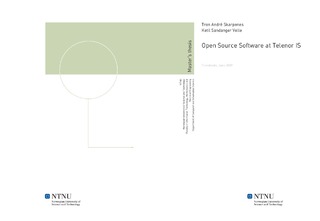| dc.description.abstract | Open Source Software (OSS) is becoming a real alternative to proprietary software because of the attractive characteristics it might bring (e.g. reduced costs, independence from vendors and increased innovation). Consequently, adoption of OSS is getting more attention and the industry is adopting OSS in a much larger scale than before. Telenor IS, the information system branch of Telenor Nordic, has realized that OSS adoption is increasing and noticed the advantages that OSS might bring for them. Therefore they have started a project called Open Source 2010. Among this project s goals are finding suitable OSS products to use within the company, and to increase the overall adoption of OSS to avoid lock-in to commercial vendors and be able to cut costs. As part of the Open Source 2010 project, we investigated three issues. The first is what concrete experience the individual employee has with OSS. The second is to examine the employees attitude towards OSS, and how they assess an increased use of OSS in Telenor IS. The third is exploring which advantages and risks OSS could bring, in addition to which preparations that should be made to ease the adoption of OSS. To investigate these issues, we cooperated with Telenor IS to develop a survey consisting of both interviews and a questionnaire. To validate, supplement and disseminate the results from the survey, two workshops were conducted with Telenor employees. This thesis has three main contributions. 1. Empirical findings showing that: (i) There is no real difference in attitudes towards OSS between leaders and non-leaders. (ii) A notable amount of OSS is in use, supporting that OSS adoption is increasing. (iii) Leaders are not necessarily aware of all the OSS being used. 2. Identification of several advantages, risks and preparations which are important to consider when increasing use of OSS. Several of these are generalizable, and could be considered by other companies planning to adopt OSS. 3. Increasing the visibility of the OSS project inside the Telenor IS organization. This is important, so that the individual employee in Telenor becomes aware of the project. In addition to increased visibility, the survey involves the employees and makes their voice heard in the OSS adoption process. | nb_NO |

